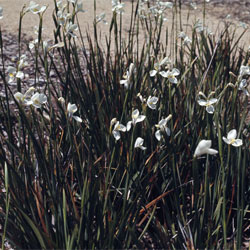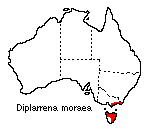Diplarrena moraea
 |
 |
Butterfly Flag, White Iris
Diplarrena is a monotypic genus of perennial small herbs, which is endemic to Australia. Well-grown plants form thick clumps with long narrow leaves and white flowers. The flowers are faintly scented and are borne at the ends of slender stems. These plants belong to the family Iridaceae and closely resemble the widely cultivated exotic Iris.
Some botanists recognise two species in the genus Diplarrena, but there is strong evidence to indicate that there is only one and the latter course is followed in this article. D. moraea can be quite variable and the second species, D. latifolia, which has been described from Tasmania, may be only a robust alpine form of D. moraea. The genus has been spelled Diplarrhena, but the currently accepted spelling deletes the 'h'.
 The
Butterfly Flag (D. moraea) is a widely distributed monocot, found growing
naturally on a variety of soil types in Victoria and Tasmania and in the south-east
region of New South Wales. It is common in Tasmania where it is known as the
White Iris.
The
Butterfly Flag (D. moraea) is a widely distributed monocot, found growing
naturally on a variety of soil types in Victoria and Tasmania and in the south-east
region of New South Wales. It is common in Tasmania where it is known as the
White Iris.
The stiff Iris-like leaves are flat and linear in shape. These erect darkish-green leaves are 5 - 10 cm wide and 50 - 100 cm long. Flower stems are usually longer than the leaves, reaching a height of around 100 cm. A number of flowers, from two to six, emerge usually one or two at a time from a single terminal head. Two green, narrow bracts subtend the white fragile flowers. The perianth consists of six delicate, white, obovate-cuneate segments with the three outer ones being about 2 - 3 cm long and 1 - 2 cm wide. The three inner segments are much smaller and more erect and are usually tinged with yellow or purple markings. Each flower contains three free stamens, with one being much shorter than the others and without an anther. The style is longer than the stamens and is three-branched.
Fruits are oblong three-celled capsules which split open when ripe, releasing large numbers of round flat seeds. These dark brown seeds germinate readily and this is the best method of producing large numbers of plants. Another method is to divide an existing clump into two or more pieces. This is a good method of propagation when only a few new plants are required, as instant mature plants are obtained. Numerous basal leaves form dense tussock-like clumps about 20 cm in diameter.
Because of their particular habit of growth, these plants make excellent specimens for use in permanent containers. In the Australian National Botanic Gardens, these attractive small plants have been successfully used in mass plantings. Plants can also be planted singly in a rockery or as a garden specimen. Most well-drained soils that are light in texture are suitable for its cultivation.
D. moraea flowers best in full sun, with the flowers appearing in spring and continuing until early summer. This long-lived species is frost hardy and responds to adequate water and fertilising.
Plants have shown good resistance to insect and disease attack, although the tips of some leaves do become yellowish and die off. The only pruning necessary is the trimming off of these unsightly leaves and the removal of the dead flower stalks.
Text by ANBG staff (1975)
Name meaning: Diplarrhena moraeaDiplarrena - a Greek compound from diplo - 'double' and arrhen - 'male', probably referring to the two fertile stamens; moraea - probably named after the South African genus Moraea,
to which it is similar |
![An Australian Government Initiative [logo]](/images/austgovt_brown_90px.gif)

